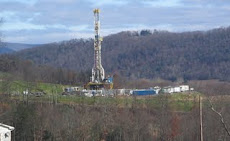Click on the link to the Merle Haggard song on youtube..
Peter
http://www.youtube.com/watch?v=0n552gP9X40
Who's Looking At Natural Gas Now? Big Oil

Gastar Exploration, a small Texas company, is digging a shallow natural gas well in Clarksburg, W.Va. Gastar's

Gastar Exploration, a small Texas company, is digging a shallow natural gas well in Clarksburg, W.Va. Gastar's business strategy is to limit its exploration and drilling to a minimum in the Appalachian region until it sees how larger gas companies fare in the area.
But their business is booming. New production techniques in recent years have enabled companies to extract natural gas from shale rock formations deep underground. As a result, estimates of accessible natural gas reserves have been revised dramatically upward. Small gas producers can justifiably take the
Read The Shale Series
"The major oil companies haven't been paying attention to the U.S. for decades," says Robert Hefner, a 50-year veteran of the natural gas business with a company of his own, GHK Exploration, in Oklahoma City. "It's been a lot of independents like us that have found all this gas, developed the technology and made it happen."
Hefner attributes the proliferation of small natural gas companies to the fact that individual landowners generally retain the mineral rights to their own property. "In America, if [your] dream is to drill a well, you can go out and drill a well," Hefner points out. "As a result, there's been about three-and-a-half-million wells drilled in America over the years, versus about a million and a half for the rest of the world."
Mom-And-Pop Businesses
Many of those natural gas wells are mom-and-pop operations, or began that way. Often they evolve into slightly larger companies, but even the publicly traded companies are generally small. Those that survive in the energy world have learned to leverage their size.
U.S. Energy Consumption, By Fuel Type
Natural gas accounts for just 22 percent of the nation's energy consumption. Natural gas advocates say that increased use would mean a cleaner environment and less dependence on foreign oil.

Notes
Percentages do not total 100."We certainly don't have an advantage when it comes to capital," says J. Russell Porter, chairman and chief executive of Gastar Exploration, a Houston-based company with just 23 employees. "The large companies can spend a lot more money than we can. But we can be very quick on the draw, if you will, to seize an opportunity and buy into a new concept or a new area that we think could be prospective for natural gas. If we do that, we usually have a first-mover advantage."
The agility of small companies is an important strength in a field where the ability to move fast is key to maintaining a competitive edge. But there is also a more practical reason small companies dominate the U.S. natural gas business. Typically, a new gas well produces in abundance in the year after it's opened, but then production begins to decline. If a natural gas company is to keep production and revenue steady, it has to keep drilling new wells. The energy majors may not have the patience for that effort.
"Big oil companies like big projects that they can manage over 30 and 40 years," says Nikos Tsafos, natural gas analyst at PFC Energy in Washington. "They prefer those over the project that you need to stay on top of every single day, every single month."
There's no dispute on that point from the oil majors. "With a company our size, we have to have a larger scale," says Patrick McGinn, spokesman for Exxon Mobil's exploration arm. "We have to have a potential resource that has more capability for us to go after."
More About The Quest For Shale
Modern Shale Gas Development In The United States: A Primer by the U.S. Department of Energy (PDF)
The American Clean Skies Foundation is a nonprofit devoted to educating the public about natural gas and its relation to renewable energy and energy efficiency.
The Ground Water Protection Council monitors regulation of natural gas drilling and production in the U.S.
Worldwatch Institute, an independent research group based in Washington, D.C., conducts research about energy and climate change.
Managing Innovation And Risk
The natural gas industry, in fact, serves as a case study demonstrating how business strategies vary according to a company's size. From small to large, energy companies manage innovation and risk in ways appropriate to their own circumstances.
Gastar Exploration, like many other natural gas companies, is currently focused on the Marcellus shale formation in the Appalachian basin, perhaps the most promising area for natural gas development in the United States today. But the company has so far limited its activity in the area to a few shallow wells in West Virginia, choosing to let a few larger gas companies take the lead in the area.
"We look at what they're doing," says Gastar CEO Porter. "[We] let them drill some of the early wells, try to determine which drilling techniques work the best, and then once they have done that trial and error and established a pattern that works, we can go in and design our wells without having that trial-and-error phase, which can be very expensive."
The challenge of managing risk is important in any new industrial venture. In the natural gas business, the smallest companies in some ways can be the most adventurous. The new investments they make are tiny compared with what a large company would make. But they will still try to shift as much of the risk to their rivals as they can, just as Gastar is doing.
A Magnet For Big Oil
Paradoxically, the biggest energy companies follow a similar strategy, though in their case they try to shift risk to their smaller rivals. Shale production in the United States looks so promising right now that the big oil companies are thinking about getting back into the natural gas business. Exxon, for example, is looking at some possible shale "plays" in the United States, but — like Gastar — the company is biding its time before making a big move.
"We've taken a couple of years to really work on the technology that's required to do the exploration and production of these kinds of shale plays," says spokesman McGinn. "Doing the homework and doing the technology development takes some time for us, and we are willing to wait for that."
The possibility of Exxon's entry into the U.S. shale gas business would have major implications for a "micro-cap" company like Gastar Exploration, but Porter, Gastar's CEO, is not overly concerned.
"We can live on the fringes if necessary," he says. Or Gastar could just let the big oil companies take over some of its gas operations — for the right price.
"If Exxon came in and wanted to become a dominant player in the Marcellus shale, I'm sure there are lots of small operators who would be willing to sell out to them if they were willing to pay full value," Porter says. "There's always going to be another play for us to go invest in and start creating value all over again."
It's all part of the natural gas business game.







